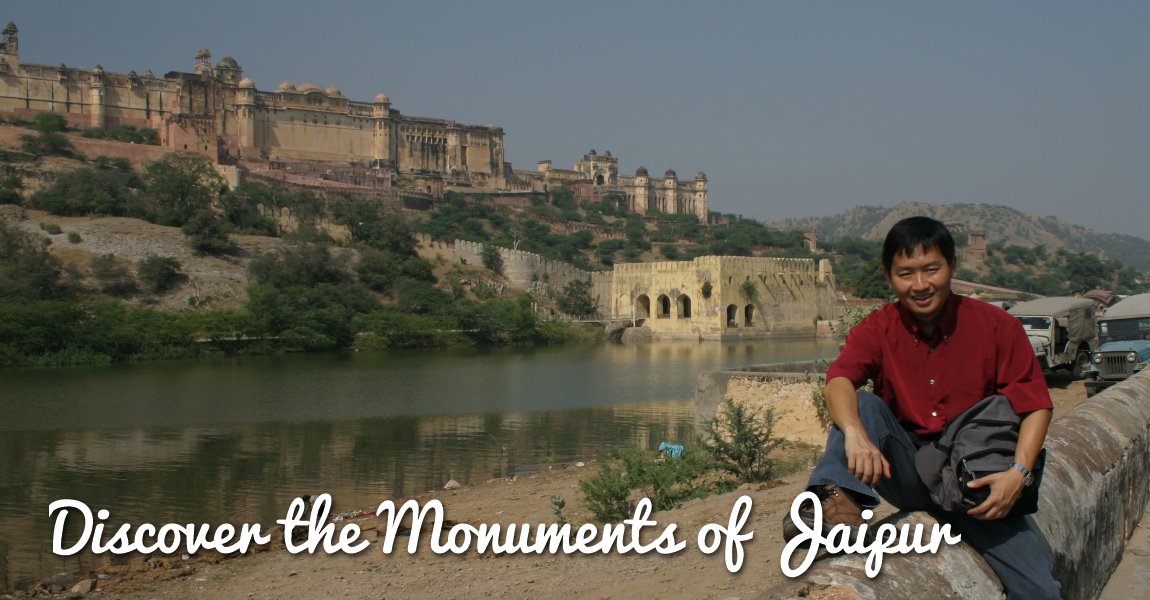 Discover the Monuments of Jaipur, India (7 November, 2004)
Discover the Monuments of Jaipur, India (7 November, 2004)
Jaipur is the largest city as well as the capital of the Indian state of Rajastan. Built by Maharajah Sawai Jai Singh II in 1727, it was India's first planned city. Popularly known as the Pink City on account of its buildings which are painted an earthy red colour to imitate the red sandstone used in Mughal architecture, Jaipur was formerly the capital of the principality of Jaipur. Jaipur is the gateway for visitors to other cities in Rajastan such as Jodhpur and Jaisalmer. Many of the heritage buildings in Jaipur were painted an earthy red colour, to imitate the red sandstone used in Mughal structures. As a result, Jaipur is also called the Pink City.
Location of Jaipur on Map
Places of Interest in Jaipur
- Albert Hall (GPS: 26.91108, 75.81954)

- Amber Fort (GPS: 26.9857, 75.85061)

- Birla Mandhir (GPS: 26.89192, 75.81552)

- Chandra Mahal (GPS: 26.9268, 75.82338)

- City Palace Museum (GPS: 26.92543, 75.82385)

- Diwan-i-Khas (GPS: 26.92647, 75.82386)

- Hawa Mahal (GPS: 26.92377, 75.82673)

- Jal Mahal (GPS: 26.95307, 75.84615)

- Jantar Mantar (GPS: 26.92407, 75.8242)

- Kesar Kyari Bagh (GPS: 26.98442, 75.85254)

- Moti Doongri (GPS: 26.89321, 75.81673)

- Rajendra Pol (GPS: 26.92609, 75.82378)

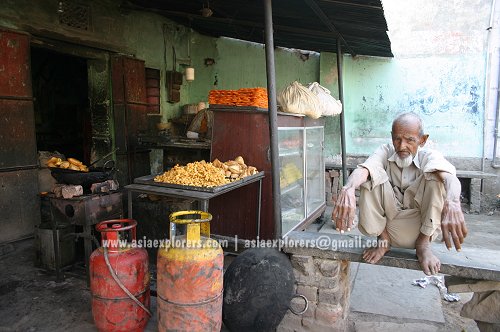 Jaipur food vendor (7 November 2004)
Jaipur food vendor (7 November 2004)
While most northern Indian cities were a chaotic ensemble of twisting alleys and bore no resemblance to the principles set out in Hindu architectural manuals, Jaipur stands out as one of the best planned cities. Maharajah Sawai Jai Singh II was a noted astronomer and town planner, and so Jaipur was created with adherence to Hindu astronomical and architectural principals. The city is laid out to create six quarters separated by wide boulevards 111ft (34m) wide. Each quarter is further divided by gridded streets.
Jaipur, popularly known as the Pink City, is the capital of the state of Rajasthan. It is regarded as the third corner of India's Golden Triangle, 300 kilometres southwest of Delhi, and 200 kilometres west of Agra.
The old city of Jaipur is partially encircled with seven gates - the major ones being Chandpol, Sanganeri, and Ajmeri. The 'pink city' label applies specifically to the old walled quarter, while in the northeast of the town, glorious palaces and temples come in an assortment of styles, spanning centuries, are scattered throughout the predominantly urban area.
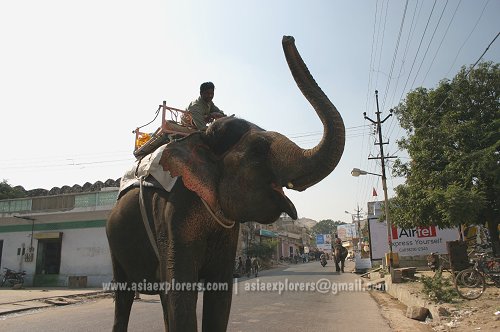 Elephant in the streets of Jaipur (7 November 2004)
Elephant in the streets of Jaipur (7 November 2004)
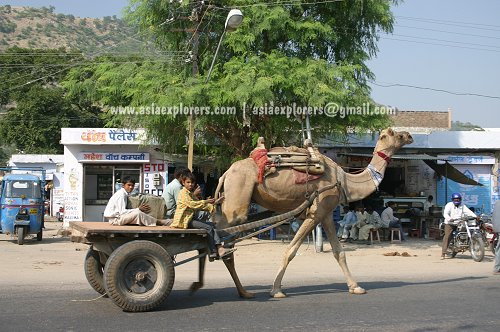 Children riding a camel cart in Jaipur (7 November 2004)
Children riding a camel cart in Jaipur (7 November 2004)
Like his predecessors, Jai Singh enjoyed good relations with the Mughals, and was careful to cultivate this alliance. In 1727, with Mughal power on the wane, Jai Singh decided to move down from his hillside fortress capital at Amber, to a new site on the plains. A Bengali architect Vidhyadhar Bhattacharya designed the city, using the principles of town planning, as laid down in the Shilpa Shastra, an ancient Hindu treatise on architecture. He built the City Palace as well as the largest stone observatory in the world, the Jantar Mantar, employing the same principles.
Jaipur is an extremely colourful city, and in the evening light, the pink and the orange buildings exude a magical glow complemented by the vibrantly attired Rajasthanis. Camel drawn carts add character to its streets.
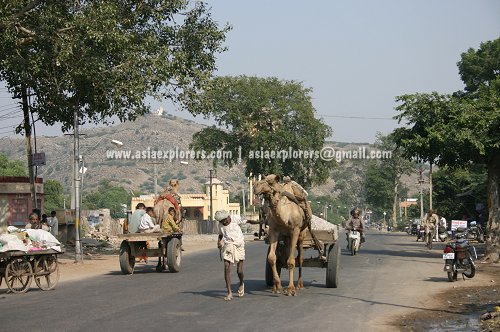 Camels in the streets of Jaipur (7 November 2004)
Camels in the streets of Jaipur (7 November 2004)
The Jantar Mantar is an observatory constructed by Jai Singh in 1728, to satisfy his passion for astronomy, which was even more notable than his prowess as a warrior. The Jaipur observatory is the largest, and the best preserved of the five observatories he built. The others are in Delhi, Varanasi and Ujjain. The observatory at Mathura, has now disappeared.
Located in the Ram Niwas Gardens, in the south of the old city, is Central Museum, also known as Albert Hall. It was designed by Sir Samuel Swinton Jacob as commissioned by Sawai Ram Singh II to honour the visit of Albert, Prince of Wales, in 1876. Swinton Jacob employed the Indo-Saracenic style of architecture on this building, combining contemporary European design with traditional Indian elements. Today it houses portraits of the Jaipur Maharajas, a collection of costumes, and woodwork from various parts of the state, and other miniatures and artworks. There is also a zoo, and an art gallery, located in the Gardens.
History of Jaipur
The state of Jaipur has already existed since the 12th century. It was founded in around 1097 by Dulaha Raya from Gwalior. The rulers, or maharajahs, of Jaipur belong to the Kachwaha clan of Rajputs, a Kshatriya caste of Hindus in Rajastan who ruled princely states at the same time as the Mughal empire. The Jaipur dynasty provided the Mughals with many of their distinguished generals, including Raja Man Singh I, Jai Singh I, and Jai Singh II also called Sawai Jai Singh, who founded the city of Jaipur. The maharajahs of Jaipur claim to have descended from Rama, the king of Ayodhya.In 1803, Maharajah Sawai Jagat Singh signed a treaty with the British. The maharajahs continued to rule the state of Jaipur until 1948, after India's independence, when Maharajah Sawai Man Singh II acceded it to the Government of India. The city of Jaipur was then made the capital of Rajastan.
Getting into Jaipur
By plane: Most visitors arrive by coach (tourist bus) from Delhi or Agra, doing the so-called Golden Triangle circuit which is the most popular for visitors to India. For those wishing to fly direct to Jaipur, Sanganer Airport (JAI) caters to flights from Delhi, Mumbai, Kolkata and Udaipur in Rajastan. Air Arabia also flies from Jaipur to Sharjah and Muscat.By train: The two main railway stations of Jaipur are the Jaipur station and the Durgapura station. Rail connect available to Delhi, Agra and Mumbai.
By road: National highway No. 8 connects Delhi to Jaipur. Journey is expected to take at least four hours.
Getting around Jaipur
The easiest way is to take the auto rickshaw. Prepaid auto rickshaws are available at the Jaipur railway station. Pay in advance and then give your coupon to the driver (wallah) at the end of your journey. Disregard any attempts from the wallah to get any additional cash from you. Latest updates on Penang Travel Tips
Latest updates on Penang Travel Tips
 Map of Roads in Penang
Map of Roads in Penang
Looking for information on Penang? Use this Map of Roads in Penang to zoom in on information about Penang, brought to you road by road.
Copyright © 2003-2025 Timothy Tye. All Rights Reserved.

 Go Back
Go Back